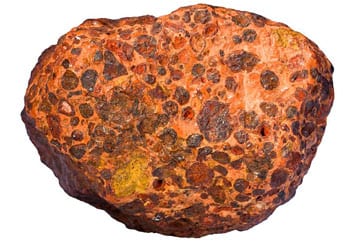Vyberte jazyk:
Hliník je najbežnejší kovový prvok nájdený na zemi, totaling about 8% zemskej kôry. Avšak, aluminum as an element is reactive and therefore does not occur naturally – it needs to be refined to produce aluminum metal. Primárnym východiskovým materiálom pre rafináciu hliníka je bauxit, Hlavný komerčný zdroj hliníka na svete. Bauxite is a sedimentary rock, and consists mostly of the aluminium minerals gibbsite (Al(OH)3), Boehmite (γ-AlO(OH)) a diaspóry (α-AlO(OH)), and is usually mixed with the two iron oxides goethite and hematite, the aluminium clay mineral kaolinite and small amounts of anatase (TiO2) and/or ilmenite (FeTiO3).

Ložiská bauxitu sú rozšírené po celom svete, väčšinou sa vyskytuje v tropických alebo subtropických oblastiach. Although proven reserves of bauxite are expected to last for many years, Kvalita rezerv, ktoré sú ekonomicky dostupné, klesá. Pre rafinérie, who are in the business of bauxite processing to make alumina, a nakoniec hliníkový kov, Je to výzva s finančnými aj environmentálnymi dôsledkami.
The process to refine metallurgical bauxite into alumina involves the following inputs:
The following outputs are generated:

The most widely used chemical process of refining bauxite into alumina, Bayerov proces, involves dissolving the Al2O3 out of the bauxite rock with caustic soda (NaOH) at elevated temperature and pressure. The Al2O3 fraction of the bauxite is dissolved into solution, to later be precipitated out as alumina. Avšak, a high-grade bauxite contains up to 60% Al2O3, and many operating bauxite deposits are well below this, príležitostne tak nízke ako 30-40% Al2O3. Because the desired product is a high purity Al2O3, zvyšné oxidy v bauxite (Fe2O3 (Fe2O3), SiO2, TiO2, Organic material) are separated from the Al2O3 and rejected as alumina refinery resides (ARR) or red mud. Všeobecne platí, že, čím nižšia kvalita bauxitu (ie lower Al2O3 content) the more red mud is generated per ton of alumina product. okrem toho, even some Al2O3 bearing minerals, najmä kaolinit, produce un-desirable side reactions during the refining process and lead to an increase in red mud generation, ako aj strata drahej chemikálie hydroxidu sodného, veľké variabilné náklady v procese rafinácie bauxitu.
Červený kal alebo ARR predstavuje veľkú a pretrvávajúcu výzvu pre hliníkový priemysel. Červený kal obsahuje významné zvyšky žieraviny, ktoré zostali z procesu rafinácie, a je vysoko zásaditý, často s pH 10 – 13. It is generated in large volumes worldwide – according to the USGS, Odhadovaná celosvetová výroba oxidu hlinitého bola 121 miliónov ton v 2016. This likely resulted in more than 150 milión ton červeného bahna vyprodukovaného počas rovnakého obdobia. Napriek prebiehajúcemu výskumu, Červený kal má v súčasnosti len málo komerčne životaschopných ciest k prospešnému opätovnému použitiu. Odhaduje sa, že veľmi málo červeného bahna sa na celom svete skutočne opätovne využíva. Instead the red mud is pumped from the alumina refinery into storage impoundments or landfills, ak sa skladuje a monitoruje s veľkými nákladmi.
Strata drahej hydroxidu sodného (NaOH) and the generation of red mud are both related to the quality of the bauxite used in the refining process. Všeobecne platí, že, the lower the Al2O3 content of the bauxite, Čím väčší objem červeného bahna sa vytvorí, as the non-Al2O3 phases are rejected as red mud. okrem toho, the higher the kaolinite or reactive silica content of the bauxite, Čím viac červeného bahna sa vytvorí. The reactive silica content not only increases the volume of red mud, but also consumes caustic soda reagent and reduces the yield of Al2O3 recovered from the bauxite. Preto, there is both an economic and environmental argument to be made for improving the quality of bauxite prior to refining.
Proces suchej separácie STET ponúka výrobcom bauxitu alebo rafinériám bauxitu príležitosť vykonať modernizáciu bauxitovej rudy pred Bayerovým procesom s cieľom zlepšiť kvalitu. Tento prístup má mnoho výhod:
Zhrnutie, suché spracovanie separátorom STET ponúka príležitosti na vytváranie hodnoty pre výrobcov a rafinérie bauxitu. Predbežné spracovanie bauxitu pred rafináciou zníži náklady na chemikálie, Znížte objem generovaného červeného kalu a minimalizujte narušenie procesu.
Referencie: